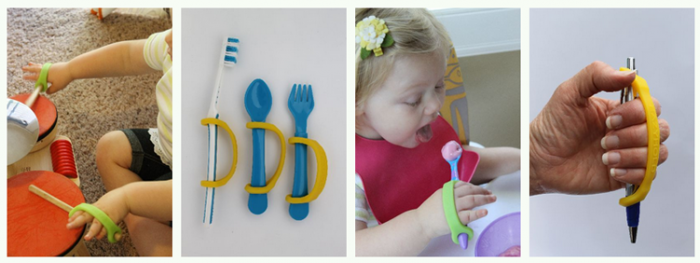Posted: August 20, 2015
Learning how to properly use eating utensils or drinking from a cup is something every child learns growing up. It is already hard enough for young children to master this, but even harder for children with Cerebral Palsy. It may be challenging to hold onto a spoon, scoop food off of a plate, or drink spill-free out of a cup. Not being able to feed themselves can cause children frustration and a lack of independence. Every child should have the opportunity to feed themselves and eating utensils can now adapt to the needs of children who found eating difficult.
There are many different kinds of spoons and forks that could fit your child’s needs. Padded spoons and forks make it easier for children with low fine-motor skills to grip utensils. Some even come with grips to stop the hands from slipping. There are also curved or bent utensils that will make it easier to get the food from the plate straight into their mouths. But what about the children who can’t grip at all? There are spoon and fork cuffs that can be attached to silverware that easily slip over your child’s hand. No matter what the challenge is, there are tools that can make eating with spoons and forks easier.
Plates and bowls can make eating harder for children with Cerebral Palsy, but with the right kind, it can make it easier. Scooper plates or bowls have curved outer edges to prevent food from spilling over the edge and make scooping food onto a spoon or fork easier. They also come with suction bottoms to keep the plate or bowl from slipping away from the child. If you want to use regular dishes, there are plastic food bumpers and food guards that can be attached onto plates that will act as raised edges to keep food from spilling over while scooping food. For those who don’t like their different foods mixing, there are partitioned dishes as well. You can check out all these options out by clicking here.
Lastly, there are cups that will make drinking less of a challenge. Cups with cutouts will make it possible to drink without tilting your head back. There are also cups with large handles to make holding it easier, or there are soft cups that help make gripping easier as well. Also, there are one way straws that will prevent swallowing air by keeping fluid in the straw at all times.
It’s worth noting that there are also simple devices, like EazyHold, that can help children with special needs overcome grip issues to utilize everyday items!
Eating and drinking can cause frustration and a lack of independence for children with Cerebral Palsy, but it doesn’t have to be that way. The challenging of feeding oneself can be lessen by using utensils and dishes designed for a wide-range of needs. We hope that this post can make it easier to find tools that your child can use and strive with. If you have any suggestions or tips for making mealtime easier for children with CP, please submit them through a comment.
If you have any questions regarding Cerebral Palsy or eating utensils for children with CP, feel free to call us at (800) 692-4453![]() (800) 692-4453 FREE or fill out our contact form on Facebook or our website.
(800) 692-4453 FREE or fill out our contact form on Facebook or our website.






